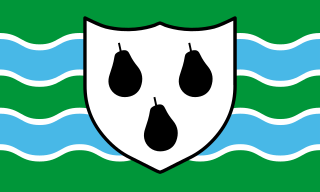
Worcestershire is a county in the West Midlands of England. The area that is now Worcestershire was absorbed into the unified Kingdom of England in 927, at which time it was constituted as a county. Over the centuries the county borders have been modified, but it was not until 1844 that substantial changes were made. This culminated with the abolition of Worcestershire in 1974 with its northern area becoming part of the West Midlands and the rest part of the county of Hereford and Worcester. However, in 1998 the county of Hereford and Worcester was abolished and Worcestershire was reconstituted without the northern area, which was ceded to the West Midlands.

Oxfordshire is a landlocked county in the far west of the government statistical region of South East England. The ceremonial county borders Warwickshire to the north-west, Northamptonshire to the north-east, Buckinghamshire to the east, Berkshire to the south, Wiltshire to the south-west and Gloucestershire to the west.

Lancelot Brown, more commonly known as Capability Brown, was an English gardener and landscape architect, who remains the most famous figure in the history of the English landscape garden style. He is remembered as "the last of the great English 18th-century artists to be accorded his due" and "England's greatest gardener".
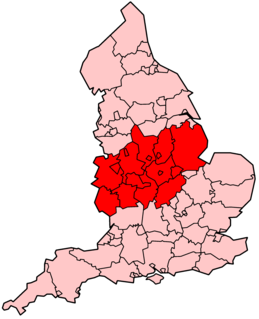
The Midlands are a part of England that broadly correspond to the Kingdom of Mercia of the Early Middle Ages, bordered by the England–Wales border, Northern England and Southern England. The Midlands were important in the Industrial Revolution of the 18th and 19th centuries. They are split into the West Midlands and East Midlands. Birmingham is the second-largest city and metropolitan area in the United Kingdom.

Sudeley Castle is a Grade I listed castle in the parish of Sudeley, in the Cotswolds, near to the medieval market town of Winchcombe, Gloucestershire, England. The castle has 10 notable gardens covering some 15 acres within a 1,200-acre estate nestled within the Cotswold hills.
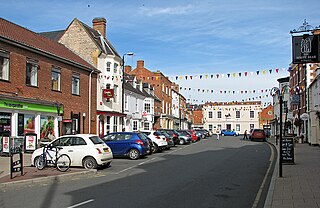
Shipston-on-Stour is a town and civil parish in the Stratford-on-Avon District in Warwickshire, England. It is located on the banks of the River Stour, 9 miles (15 km) south-southeast of Stratford-upon-Avon, 10 miles north-northwest of Chipping Norton, 14 miles (22 km) south of Warwick and 14.5 miles west of Banbury. In the 2011 census, Shipston-on-Stour had a population of 5,038.
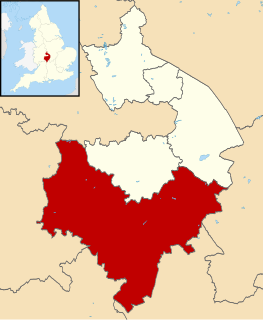
Stratford-on-Avon is a local government district in southern Warwickshire, England.

Barcheston is a village and civil parish in the Stratford-on-Avon district of Warwickshire, England. The village is on the east bank of the River Stour, opposite Shipston-on-Stour. It shares a parish council with Willington. The parish, administered at its lowest level by the Barcheston and Willington Parish Meeting, is in the Ettington ward of the district council. According to the 2001 Census the parishes population was 134, increasing to 141 at the 2011 Census.
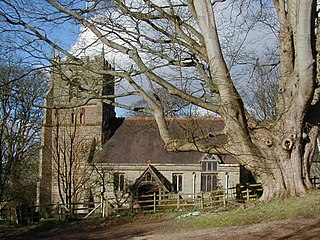
Beoley is a small village and larger civil parish north of Redditch in the Bromsgrove District of Worcestershire. It adjoins Warwickshire to the east. The 2001 census gave a parish population of 945, mostly at Holt End. The parish includes the hamlet of Portway, adjacent to the A435 road. It adjoins the Redditch suburb of Church Hill and the civil parishes of Alvechurch, Tanworth-in-Arden, Mappleborough Green and Wythall.
Lord Lovel is number 75 of the ballads anthologized by Francis James Child during the second half of the 19th century, and exists in several variants. This ballad is originally from England, originating in the Late Middle Ages, with the oldest known versions being found in the regions of Gloucestershire, Somerset, Worcestershire, Warwickshire, and Wiltshire.

Chastleton House is a Jacobean country house at Chastleton, Oxfordshire, England, close to Moreton-in-Marsh. It has been owned by the National Trust since 1991 and is a Grade I listed building.

Chastleton is a village and civil parish in the Cotswold Hills in Oxfordshire, England, about 4 miles (6.4 km) northeast of Stow-on-the-Wold. Chastleton is in the extreme northwest of Oxfordshire, on the boundaries with both Gloucestershire and Warwickshire. The 2011 Census recorded the parish's population as 153.
Robert Fisher Tomes was an English farmer and zoologist.

In needlework, a slip is a design representing a cutting or specimen of a plant, usually with flowers or fruit and leaves on a stem. Most often, slip refers to a plant design stitched in canvaswork (pettipoint), cut out, and applied to a woven background fabric. By extension, slip may also mean any embroidered or canvaswork motif, floral or not, mounted to fabric in this way.
Edward Sheldon was an English translator of four Catholic works. Two of them appeared in the troublesome period of the Stuart Restoration.

The Cloth of St Gereon is a mural tapestry of a repeat pattern with a decorative motif of a bull being attacked by a griffin, a fantastic creature with the body of a lion and the head and wings of an eagle. The Cloth of St Gereon is regarded as the oldest or second oldest known European tapestry still existing, dating to the early 11th century, compared to the Överhogdal tapestries, which in 2005 were redated to the same period, or a little later. A number of European museums hold sections of the original cloth, which was cut into fragments in the 19th century.

The Four Shire Stone is a boundary marker that marks the place where the four historic English counties of Warwickshire, Oxfordshire, Gloucestershire, and Worcestershire once met. Since 1931, with a change to the boundaries of Worcestershire, only three of the counties meet at the stone.
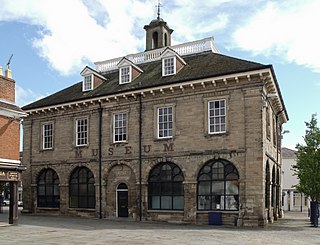
Market Hall Museum is an historic museum located in Warwick, in Warwickshire, England. The Market Hall forms part of The Warwickshire Museum, alongside St John's House. The Warwickshire Museum is operated by Heritage and Culture Warwickshire. The collections on display at Market Hall are primarily focused on objects in the fields of archaeology, geology and natural history, and particularly those local to Warwickshire.
Ralph Sheldon (1623–1684) was an English Roman Catholic Royalist and an antiquary. In his will he bequeathed his library and manuscripts to the College of Arms, his country's authority over heraldry and pedigree.

Evenlode is a village and civil parish in the Cotswold District of eastern Gloucestershire in England.


















